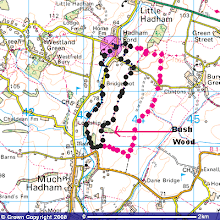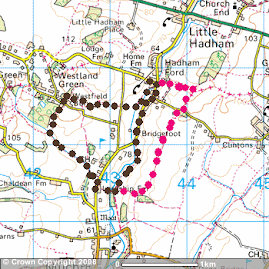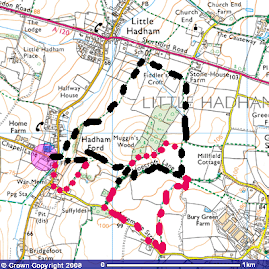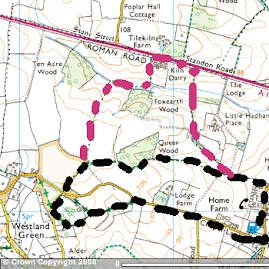October started with 460 moth species recorded for the year and a total of 9094 moths. The race was on.
Unfortunately, a cold snap at this time of year can decimate moth numbers, so pleased to record moths every night apart from 14th and 15th Oct (weekend break in North Norfolk) and 24th - 26th October (bird photo shoot in Aviero, Portugal.
Whilst numbers remained reasonable, new species were hard to come by, having to wait until the 4th for a Merveille du Jour in the garden. The same night I took a Blair's Shoulder Knot, also garden, before the 1st Brick of the year in Millennium Wood on the 5th. The following night my only Mallow of the year to the garden trap but more pleasingly, my first ever Dark Sword grass to the Skinner. This species has been recorded in the parish by Graeme Smith (GJS) but my first record. Things were becoming slower and the next new for year was on the 13th, a Green Brindled Crescent, with a November moth (gen det GJS) on the 16th, and a Pale November moth (gen det GJS) from Brick Kiln Hill opposite local village pub on the 21st.
 |
| Barred sallow (left) and Sallow |
 |
| Blair's Shoulder Knot |
 |
| Blastobasis lacticolella (7 from on bramble to light on 21.x.16) |
No other new records for October apart from Phyllonorycter coryli from Millennium Wood on the 21st, Feathered thorn (28th) and Sprawler (29th.) Both taken in the garden. This meant October ended with 9360 moths of 472 species. Targets were looking tricky: time for some leaf mine action!
My first non moth night since Spring took place on the 2nd Nov, not a great start but Phyllonorycter maestingella from Pig's Green on the 3rd gave me renewed faith.
 |
| Brick |
 |
| 2 Brick, Chestnut and Green Brindled Crsecent |
 |
| Cameraria ohridella |
On Sunday 6th we had our annual leaf mining hunt day in Millennium Wood. Basically, families turn up with carrier bags and post it notes and, after an introduction from me about leaf mines and showing the leaves to look for, families disperse through Millennium Wood, returning with bulging bags of leaves for GJS and I to go through. Children love the searching and we enjoy sitting around waiting for them to return!!
In total we added 15 species to the parish list for the year, including a new for parish record of Ectodemia intimella. A good return.
 |
| Dark Chestnut |
 |
| Chestnut |
 |
| Dark swordgrass. |
The next few days I visited most of the sites I had trapped over the year to leaf mine, adding: Stigmella tityrella (beech,) Stigmella hemargyrella (beech,) Stigmella splendissimella (bramble,) Phyllonorycter harrisella (oak,) Caloptilia rufipennella (sycamore) all on the 9th and then added Tischeria ekebladella (oak,) Stigmella plagicolella (prunus) Phyllonorycter spinicolella (prunus,) Stigmella oxycanthella (prunus,) Phyllonorycter corylifoliella (hawthorn) and Phyllonorycter oxcanthae (hawthorn) on the 10th.
During the Remembrance Service by the village War Memorial on the 13th, I looked down during the 2 minutes silence and noted a leaf mine of London plane, a tree we were standing underneath. Phyllonorycter platani was new for parish records and micro number 247.
At this point numbers of micros become a little confusing as I was grateful to receive gen dets from GJS of micros he had saved from summer but on the 13th I passed 500 moth species with the addition of Stigmella salicis (goat willow,) Phyllonorycter salictella (willow) Phyllonorycter rajella (alder,) and Phyllonorycter kleemannella (alder.) These were all taken from trees on Ash Valley Golf Course, before a garden trap of December moth became my 253rd macro for the year. More leaf mining searches on the 16th came up with Paronix fagivora on beech and Phyllonorycter geniculella from sycamore.
A December moth from Valley Fields to the actinic trap on the 15th was my 9500 moth for the year.
GJS sent through a few more July gen det records to add of Cnephasia genitalana and Coleophora pumicana on the 21st and by the 23rd I was up to 9600 for the year. On the 24th, a solitary Scarce Umber from Millennium Wood made the records. Another gen det record on the 30th November (taken 18.vii.16) was a new for parish record of Coleophora serratella, 258th micro for the year.
Consequently, November ended with 258 micros and 254 macros and a total of 9760 moths. One target achieved and seeing as I counted 110 winter moth in dusk flight in Millennium Wood on the 27th, I felt confident 10,000 was easily achievable.
 |
| December moth |
 |
| Feathered Thorn |
 |
| Merveille du Jour on lichen |
Selected macro flight times:
Beaded chestnut: 24.ix.16 - 29.x.16
Merveille du Jour: 04.x.16 - 30.x.16
Blair's Shoulder Knot: 04.x.16 - 20.x.16
Green Brindled Crescent: 13.x.16 - 03.xi.16
November moth:16.x.16 -15.xi.16
Feathered thorn : 28.x.16 - 27.xi.16
Numbers during this period supplied by:
Beaded Chestnut (44,) Merveille du Jour (8) Green Brindled Crescent (19 of which 5 were form capucina ) November moth (17) and Feathered thorn (36)
 |
| Hazel with Phyonorycter corylii and Stigmella microtheriella |
 |
| Phyllonorycter nicelii on hazel |
 |
| Satellite |
























































































